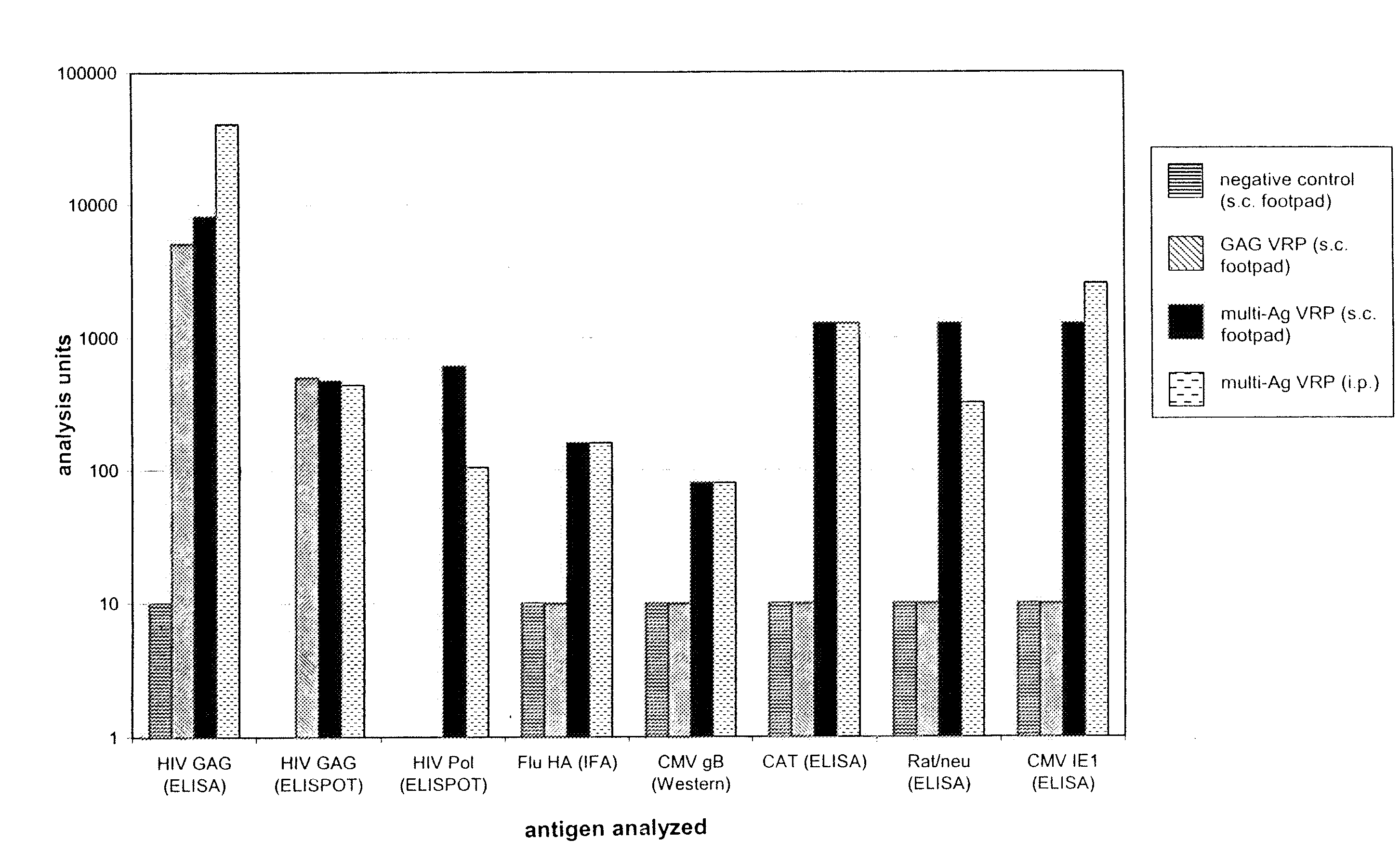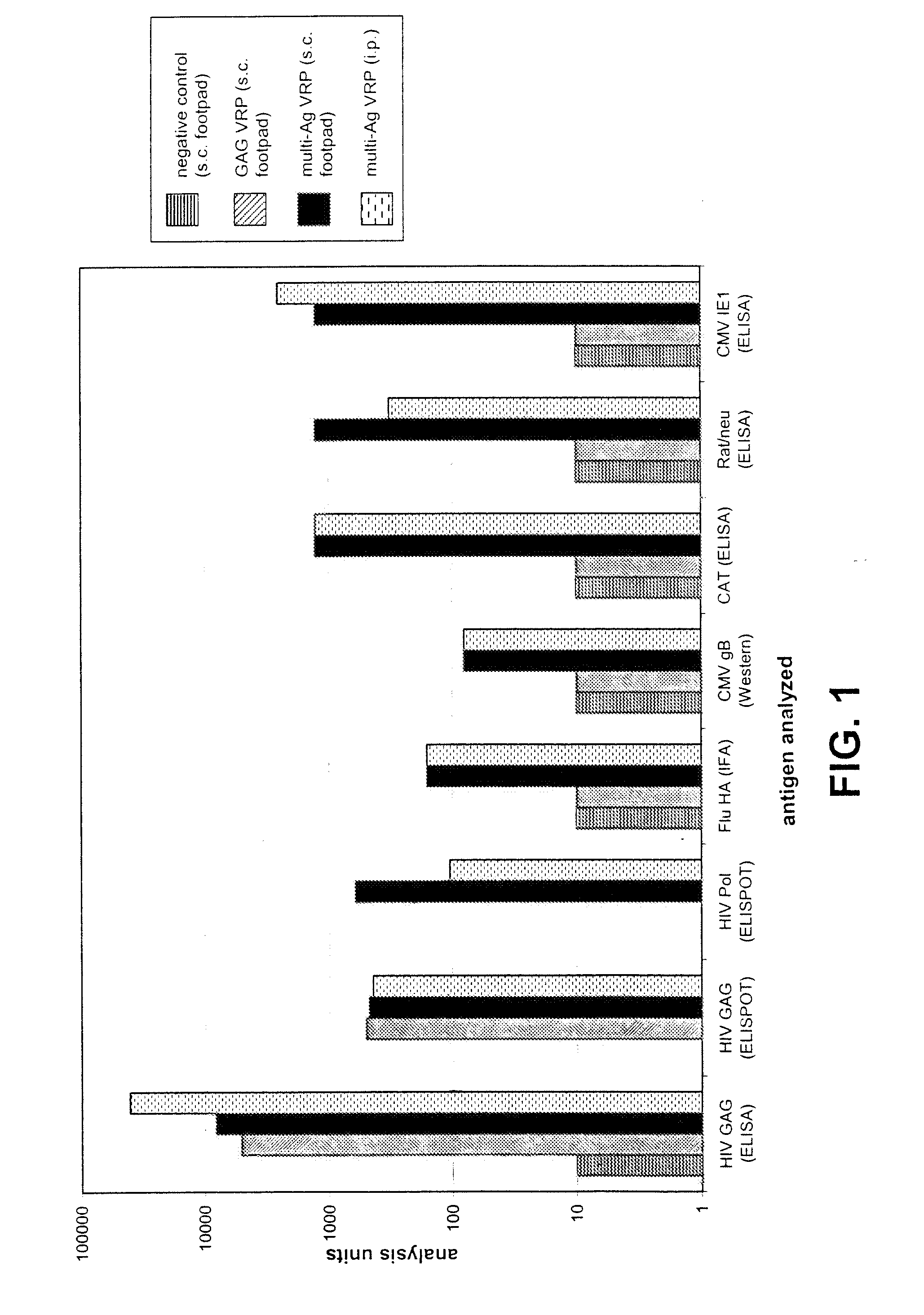Multi-antigenic alphavirus replicon particles and methods
a technology of multi-antigen alphavirus and replicon particles, applied in the field of recombinant dna technology, can solve the problems of high familial risk of breast cancer in female family members of patients, and achieve the effect of preventing regression or recurrence, and facilitating maintenance of tumor-fr
- Summary
- Abstract
- Description
- Claims
- Application Information
AI Technical Summary
Benefits of technology
Problems solved by technology
Method used
Image
Examples
example 1
Generation of Alphavirus Replicon Vectors Expressing a Library of Tumor Associated Antigens
[0075]Tumor cells are typically obtained from a cancer patient by resection, biopsy, or endoscopic sampling; the cells may be used directly, stored frozen, or maintained or expanded in culture RNA is extracted from tumor cells using standard methods known in the art, e.g. using commercially available reagents and kits such as Trizol (Sigma, St. Louis, Mo.) or S.N.A.P. total RNA isolation kit (Invitrogen, Inc, Carlsbad, Calif.), followed by mRNA purification on oligo (dT)-Sepharose. mRNA can be further enriched in tumor-specific sequences by subtractive hybridization or other method known in the art. First-strand cDNA is synthesized using oligo (dT) oligonucleotides with a rare restriction site at 5′-terminus. Following purification of the cDNA, the second strand is produced using any of the standard methods, e.g. using DNA polymerase I-RnaseH or non-specific amplification. An adaptor is then l...
example 2
Generation of Alphavirus Replicon Vectors Expressing cDNAs Specific for Infectious Disease Organism from a Sample of Infected Tissue or Blood when the Target Gene Sequences are Known
[0077]This example describes cloning of a viral / bacterial / parasitic gene repertoire specific for an individual with either an acute or chronic infection in instances where the gene or genes of interest (i.e., the genes which encode the immunogenic moieties to be expressed by the replicons) are acquired from an agent of known sequence. An mRNA is isolated from a tissue or blood sample following standard methods known in the art, e.g. S.N.A.P. total RNA isolation kit (Invitrogen, Inc. Carlsbad, Calif.). First-strand cDNA is synthesized by any standard methods known in the art, e.g. cDNA cycle kit (Invitrogen, Inc, Carlsbad, Calif.), or using AMV reverse transcriptase and random primers. The gene(s) of interest are amplified from cDNA using target gene-specific primers, following which the amplicon is purif...
example 3
Generation of Alphavirus Replicon Vectors Expressing Infectious Disease Specific cDNA from a Sample of Infected Tissue / Blood when the Target Gene Sequences are not Known
[0079]This example describes cloning of a viral / bacterial / parasitic gene repertoire in cases where the gene or genes of interest are not of a known sequence. Viral, bacterial or parasitic mRNA is isolated from a field sample or a stock culture or purified preparation using MICROBExpress kit (Ambion, Austin, Tex.) or any other method known to those skilled in the art. First strand cDNA is synthesized using random primers, or random primers with a rare restriction site at the 5′-terminus, followed by second-strand cDNA synthesis with DNA polymerase I and RNase H using standard methods known to one skilled in the art. Double-stranded cDNA is subsequently cloned into a VEE vector after ligation of an adaptor or a linker sequence as follows. In cases when the cDNA is synthesized with a random primer containing a rare rest...
PUM
| Property | Measurement | Unit |
|---|---|---|
| Molar density | aaaaa | aaaaa |
| Molar density | aaaaa | aaaaa |
| Density | aaaaa | aaaaa |
Abstract
Description
Claims
Application Information
 Login to View More
Login to View More - R&D
- Intellectual Property
- Life Sciences
- Materials
- Tech Scout
- Unparalleled Data Quality
- Higher Quality Content
- 60% Fewer Hallucinations
Browse by: Latest US Patents, China's latest patents, Technical Efficacy Thesaurus, Application Domain, Technology Topic, Popular Technical Reports.
© 2025 PatSnap. All rights reserved.Legal|Privacy policy|Modern Slavery Act Transparency Statement|Sitemap|About US| Contact US: help@patsnap.com


